Customer Value Management: Homebase Analysis and Report
VerifiedAdded on 2020/11/12
|12
|4041
|438
Report
AI Summary
This report provides a comprehensive analysis of Customer Value Management (CVM), specifically focusing on the Homebase organization. It delves into the various components used to determine Customer Lifetime Value (CLV), including mathematical formulas, customer loyalty, and cohort analysis. The report highlights the benefits of CLV to an organization, such as cost savings, improved marketing strategies, increased sales, and better forecasting. Furthermore, it evaluates factors that influence CLV, such as product variety, measurement complexity, and the impact of online and offline channels. The report also explores different market segmentation techniques applicable to a customer base, along with decision-making models for both B2C and B2B scenarios. Finally, it examines various methods and tools for increasing customer loyalty and fostering strong customer relationships. The report emphasizes the importance of CVM for increasing profitability, building customer loyalty, and maintaining a competitive advantage in the market.
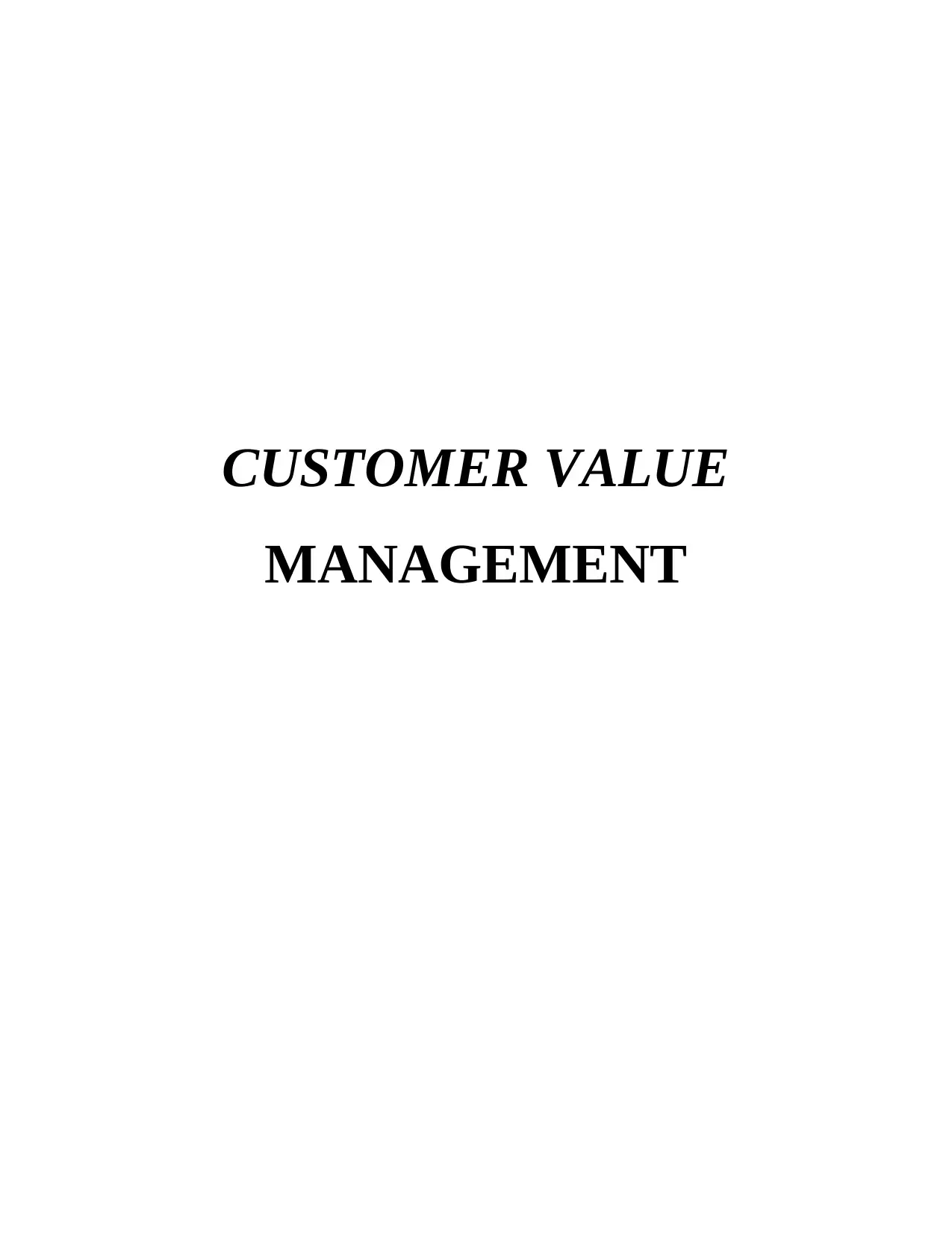
CUSTOMER VALUE
MANAGEMENT
MANAGEMENT
Paraphrase This Document
Need a fresh take? Get an instant paraphrase of this document with our AI Paraphraser
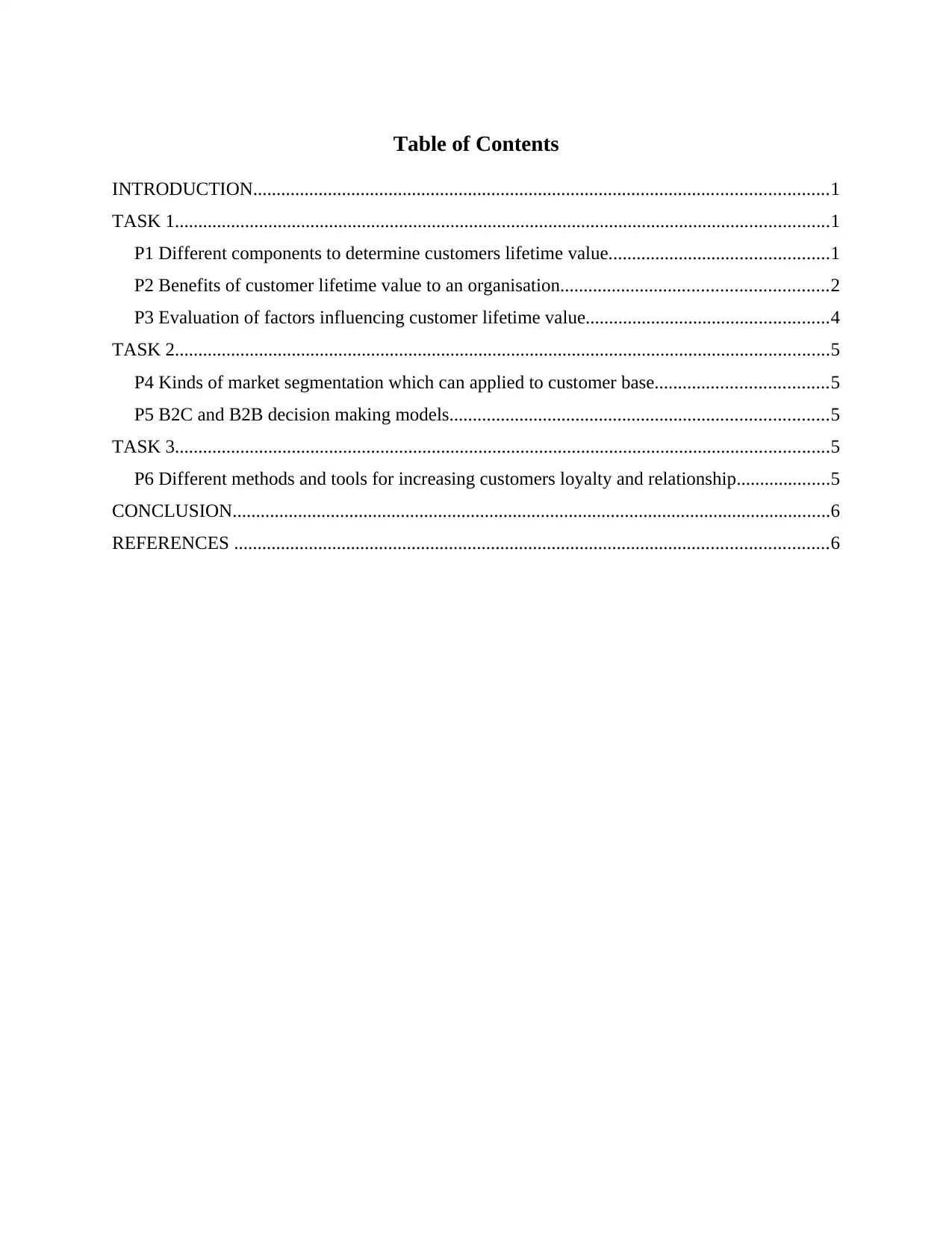
Table of Contents
INTRODUCTION...........................................................................................................................1
TASK 1............................................................................................................................................1
P1 Different components to determine customers lifetime value...............................................1
P2 Benefits of customer lifetime value to an organisation.........................................................2
P3 Evaluation of factors influencing customer lifetime value....................................................4
TASK 2............................................................................................................................................5
P4 Kinds of market segmentation which can applied to customer base.....................................5
P5 B2C and B2B decision making models.................................................................................5
TASK 3............................................................................................................................................5
P6 Different methods and tools for increasing customers loyalty and relationship....................5
CONCLUSION................................................................................................................................6
REFERENCES ...............................................................................................................................6
INTRODUCTION...........................................................................................................................1
TASK 1............................................................................................................................................1
P1 Different components to determine customers lifetime value...............................................1
P2 Benefits of customer lifetime value to an organisation.........................................................2
P3 Evaluation of factors influencing customer lifetime value....................................................4
TASK 2............................................................................................................................................5
P4 Kinds of market segmentation which can applied to customer base.....................................5
P5 B2C and B2B decision making models.................................................................................5
TASK 3............................................................................................................................................5
P6 Different methods and tools for increasing customers loyalty and relationship....................5
CONCLUSION................................................................................................................................6
REFERENCES ...............................................................................................................................6
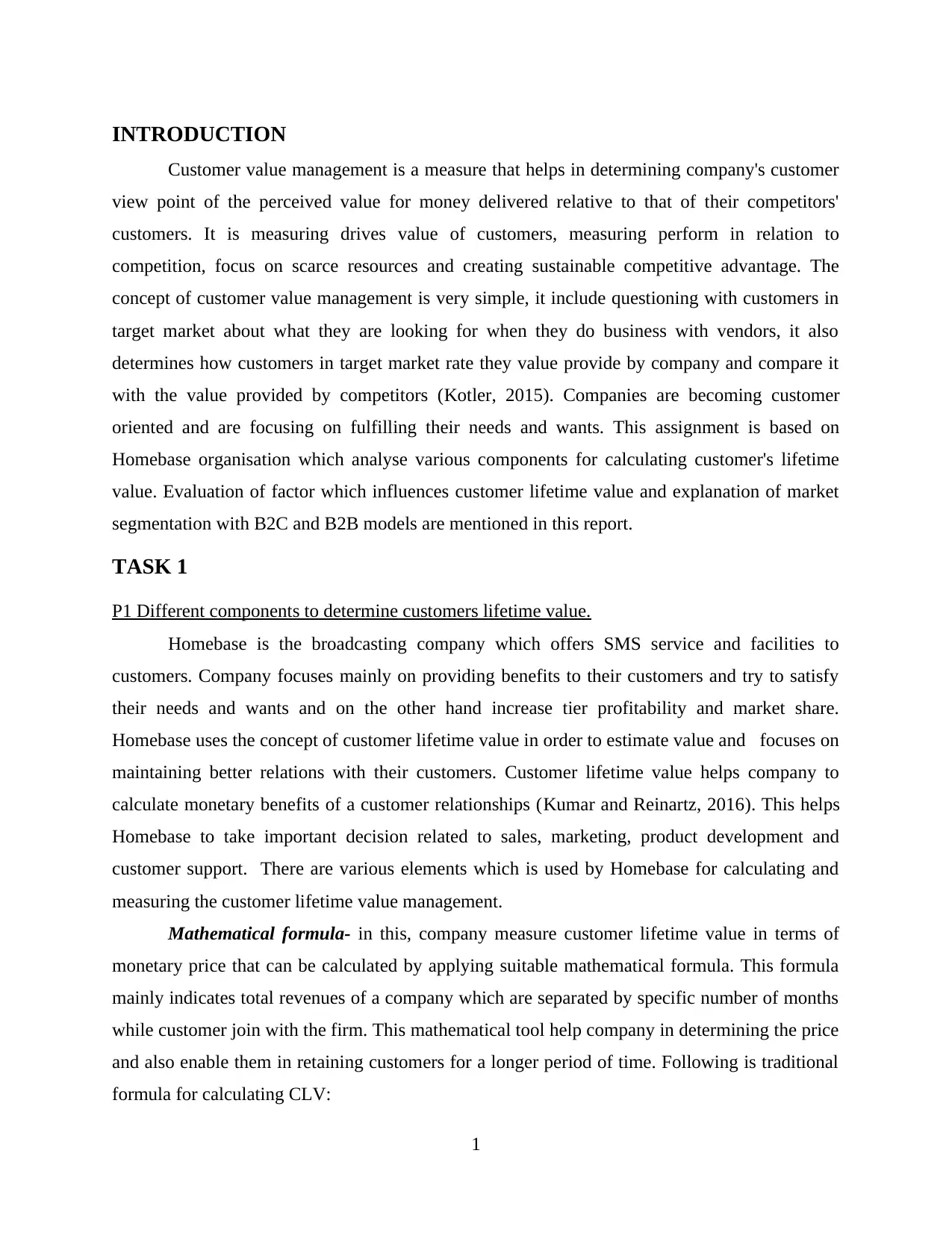
INTRODUCTION
Customer value management is a measure that helps in determining company's customer
view point of the perceived value for money delivered relative to that of their competitors'
customers. It is measuring drives value of customers, measuring perform in relation to
competition, focus on scarce resources and creating sustainable competitive advantage. The
concept of customer value management is very simple, it include questioning with customers in
target market about what they are looking for when they do business with vendors, it also
determines how customers in target market rate they value provide by company and compare it
with the value provided by competitors (Kotler, 2015). Companies are becoming customer
oriented and are focusing on fulfilling their needs and wants. This assignment is based on
Homebase organisation which analyse various components for calculating customer's lifetime
value. Evaluation of factor which influences customer lifetime value and explanation of market
segmentation with B2C and B2B models are mentioned in this report.
TASK 1
P1 Different components to determine customers lifetime value.
Homebase is the broadcasting company which offers SMS service and facilities to
customers. Company focuses mainly on providing benefits to their customers and try to satisfy
their needs and wants and on the other hand increase tier profitability and market share.
Homebase uses the concept of customer lifetime value in order to estimate value and focuses on
maintaining better relations with their customers. Customer lifetime value helps company to
calculate monetary benefits of a customer relationships (Kumar and Reinartz, 2016). This helps
Homebase to take important decision related to sales, marketing, product development and
customer support. There are various elements which is used by Homebase for calculating and
measuring the customer lifetime value management.
Mathematical formula- in this, company measure customer lifetime value in terms of
monetary price that can be calculated by applying suitable mathematical formula. This formula
mainly indicates total revenues of a company which are separated by specific number of months
while customer join with the firm. This mathematical tool help company in determining the price
and also enable them in retaining customers for a longer period of time. Following is traditional
formula for calculating CLV:
1
Customer value management is a measure that helps in determining company's customer
view point of the perceived value for money delivered relative to that of their competitors'
customers. It is measuring drives value of customers, measuring perform in relation to
competition, focus on scarce resources and creating sustainable competitive advantage. The
concept of customer value management is very simple, it include questioning with customers in
target market about what they are looking for when they do business with vendors, it also
determines how customers in target market rate they value provide by company and compare it
with the value provided by competitors (Kotler, 2015). Companies are becoming customer
oriented and are focusing on fulfilling their needs and wants. This assignment is based on
Homebase organisation which analyse various components for calculating customer's lifetime
value. Evaluation of factor which influences customer lifetime value and explanation of market
segmentation with B2C and B2B models are mentioned in this report.
TASK 1
P1 Different components to determine customers lifetime value.
Homebase is the broadcasting company which offers SMS service and facilities to
customers. Company focuses mainly on providing benefits to their customers and try to satisfy
their needs and wants and on the other hand increase tier profitability and market share.
Homebase uses the concept of customer lifetime value in order to estimate value and focuses on
maintaining better relations with their customers. Customer lifetime value helps company to
calculate monetary benefits of a customer relationships (Kumar and Reinartz, 2016). This helps
Homebase to take important decision related to sales, marketing, product development and
customer support. There are various elements which is used by Homebase for calculating and
measuring the customer lifetime value management.
Mathematical formula- in this, company measure customer lifetime value in terms of
monetary price that can be calculated by applying suitable mathematical formula. This formula
mainly indicates total revenues of a company which are separated by specific number of months
while customer join with the firm. This mathematical tool help company in determining the price
and also enable them in retaining customers for a longer period of time. Following is traditional
formula for calculating CLV:
1
⊘ This is a preview!⊘
Do you want full access?
Subscribe today to unlock all pages.

Trusted by 1+ million students worldwide
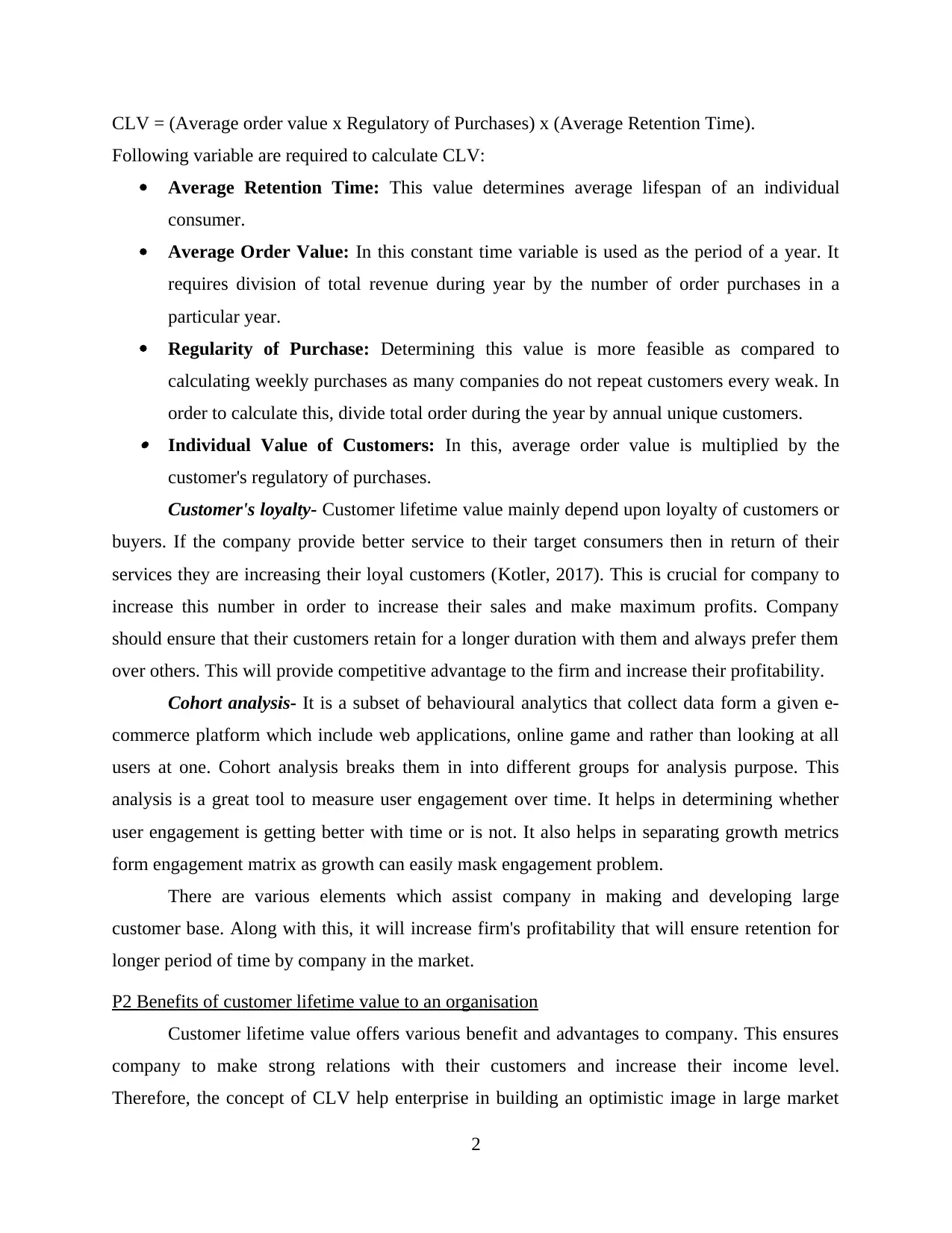
CLV = (Average order value x Regulatory of Purchases) x (Average Retention Time).
Following variable are required to calculate CLV:
Average Retention Time: This value determines average lifespan of an individual
consumer.
Average Order Value: In this constant time variable is used as the period of a year. It
requires division of total revenue during year by the number of order purchases in a
particular year.
Regularity of Purchase: Determining this value is more feasible as compared to
calculating weekly purchases as many companies do not repeat customers every weak. In
order to calculate this, divide total order during the year by annual unique customers. Individual Value of Customers: In this, average order value is multiplied by the
customer's regulatory of purchases.
Customer's loyalty- Customer lifetime value mainly depend upon loyalty of customers or
buyers. If the company provide better service to their target consumers then in return of their
services they are increasing their loyal customers (Kotler, 2017). This is crucial for company to
increase this number in order to increase their sales and make maximum profits. Company
should ensure that their customers retain for a longer duration with them and always prefer them
over others. This will provide competitive advantage to the firm and increase their profitability.
Cohort analysis- It is a subset of behavioural analytics that collect data form a given e-
commerce platform which include web applications, online game and rather than looking at all
users at one. Cohort analysis breaks them in into different groups for analysis purpose. This
analysis is a great tool to measure user engagement over time. It helps in determining whether
user engagement is getting better with time or is not. It also helps in separating growth metrics
form engagement matrix as growth can easily mask engagement problem.
There are various elements which assist company in making and developing large
customer base. Along with this, it will increase firm's profitability that will ensure retention for
longer period of time by company in the market.
P2 Benefits of customer lifetime value to an organisation
Customer lifetime value offers various benefit and advantages to company. This ensures
company to make strong relations with their customers and increase their income level.
Therefore, the concept of CLV help enterprise in building an optimistic image in large market
2
Following variable are required to calculate CLV:
Average Retention Time: This value determines average lifespan of an individual
consumer.
Average Order Value: In this constant time variable is used as the period of a year. It
requires division of total revenue during year by the number of order purchases in a
particular year.
Regularity of Purchase: Determining this value is more feasible as compared to
calculating weekly purchases as many companies do not repeat customers every weak. In
order to calculate this, divide total order during the year by annual unique customers. Individual Value of Customers: In this, average order value is multiplied by the
customer's regulatory of purchases.
Customer's loyalty- Customer lifetime value mainly depend upon loyalty of customers or
buyers. If the company provide better service to their target consumers then in return of their
services they are increasing their loyal customers (Kotler, 2017). This is crucial for company to
increase this number in order to increase their sales and make maximum profits. Company
should ensure that their customers retain for a longer duration with them and always prefer them
over others. This will provide competitive advantage to the firm and increase their profitability.
Cohort analysis- It is a subset of behavioural analytics that collect data form a given e-
commerce platform which include web applications, online game and rather than looking at all
users at one. Cohort analysis breaks them in into different groups for analysis purpose. This
analysis is a great tool to measure user engagement over time. It helps in determining whether
user engagement is getting better with time or is not. It also helps in separating growth metrics
form engagement matrix as growth can easily mask engagement problem.
There are various elements which assist company in making and developing large
customer base. Along with this, it will increase firm's profitability that will ensure retention for
longer period of time by company in the market.
P2 Benefits of customer lifetime value to an organisation
Customer lifetime value offers various benefit and advantages to company. This ensures
company to make strong relations with their customers and increase their income level.
Therefore, the concept of CLV help enterprise in building an optimistic image in large market
2
Paraphrase This Document
Need a fresh take? Get an instant paraphrase of this document with our AI Paraphraser
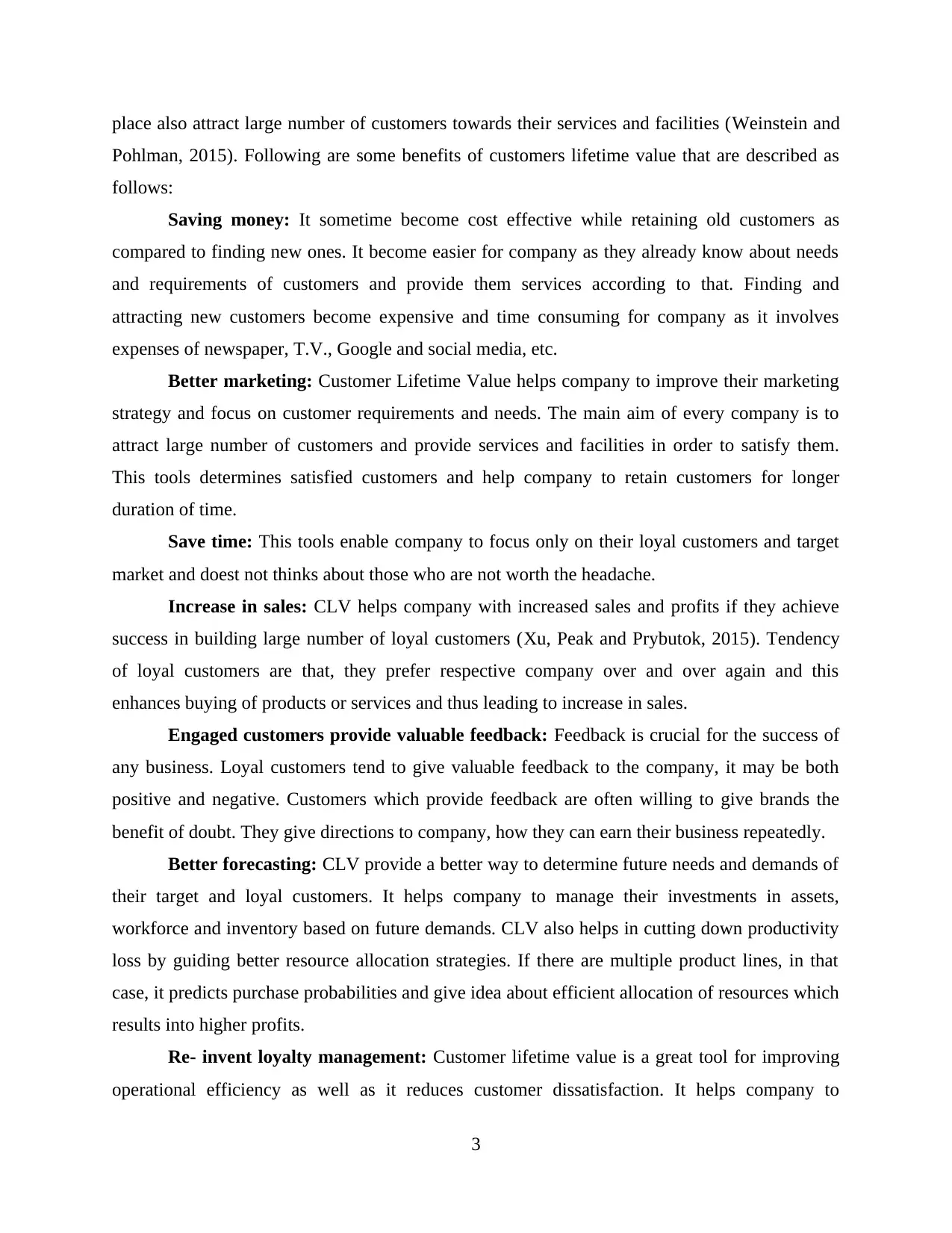
place also attract large number of customers towards their services and facilities (Weinstein and
Pohlman, 2015). Following are some benefits of customers lifetime value that are described as
follows:
Saving money: It sometime become cost effective while retaining old customers as
compared to finding new ones. It become easier for company as they already know about needs
and requirements of customers and provide them services according to that. Finding and
attracting new customers become expensive and time consuming for company as it involves
expenses of newspaper, T.V., Google and social media, etc.
Better marketing: Customer Lifetime Value helps company to improve their marketing
strategy and focus on customer requirements and needs. The main aim of every company is to
attract large number of customers and provide services and facilities in order to satisfy them.
This tools determines satisfied customers and help company to retain customers for longer
duration of time.
Save time: This tools enable company to focus only on their loyal customers and target
market and doest not thinks about those who are not worth the headache.
Increase in sales: CLV helps company with increased sales and profits if they achieve
success in building large number of loyal customers (Xu, Peak and Prybutok, 2015). Tendency
of loyal customers are that, they prefer respective company over and over again and this
enhances buying of products or services and thus leading to increase in sales.
Engaged customers provide valuable feedback: Feedback is crucial for the success of
any business. Loyal customers tend to give valuable feedback to the company, it may be both
positive and negative. Customers which provide feedback are often willing to give brands the
benefit of doubt. They give directions to company, how they can earn their business repeatedly.
Better forecasting: CLV provide a better way to determine future needs and demands of
their target and loyal customers. It helps company to manage their investments in assets,
workforce and inventory based on future demands. CLV also helps in cutting down productivity
loss by guiding better resource allocation strategies. If there are multiple product lines, in that
case, it predicts purchase probabilities and give idea about efficient allocation of resources which
results into higher profits.
Re- invent loyalty management: Customer lifetime value is a great tool for improving
operational efficiency as well as it reduces customer dissatisfaction. It helps company to
3
Pohlman, 2015). Following are some benefits of customers lifetime value that are described as
follows:
Saving money: It sometime become cost effective while retaining old customers as
compared to finding new ones. It become easier for company as they already know about needs
and requirements of customers and provide them services according to that. Finding and
attracting new customers become expensive and time consuming for company as it involves
expenses of newspaper, T.V., Google and social media, etc.
Better marketing: Customer Lifetime Value helps company to improve their marketing
strategy and focus on customer requirements and needs. The main aim of every company is to
attract large number of customers and provide services and facilities in order to satisfy them.
This tools determines satisfied customers and help company to retain customers for longer
duration of time.
Save time: This tools enable company to focus only on their loyal customers and target
market and doest not thinks about those who are not worth the headache.
Increase in sales: CLV helps company with increased sales and profits if they achieve
success in building large number of loyal customers (Xu, Peak and Prybutok, 2015). Tendency
of loyal customers are that, they prefer respective company over and over again and this
enhances buying of products or services and thus leading to increase in sales.
Engaged customers provide valuable feedback: Feedback is crucial for the success of
any business. Loyal customers tend to give valuable feedback to the company, it may be both
positive and negative. Customers which provide feedback are often willing to give brands the
benefit of doubt. They give directions to company, how they can earn their business repeatedly.
Better forecasting: CLV provide a better way to determine future needs and demands of
their target and loyal customers. It helps company to manage their investments in assets,
workforce and inventory based on future demands. CLV also helps in cutting down productivity
loss by guiding better resource allocation strategies. If there are multiple product lines, in that
case, it predicts purchase probabilities and give idea about efficient allocation of resources which
results into higher profits.
Re- invent loyalty management: Customer lifetime value is a great tool for improving
operational efficiency as well as it reduces customer dissatisfaction. It helps company to
3
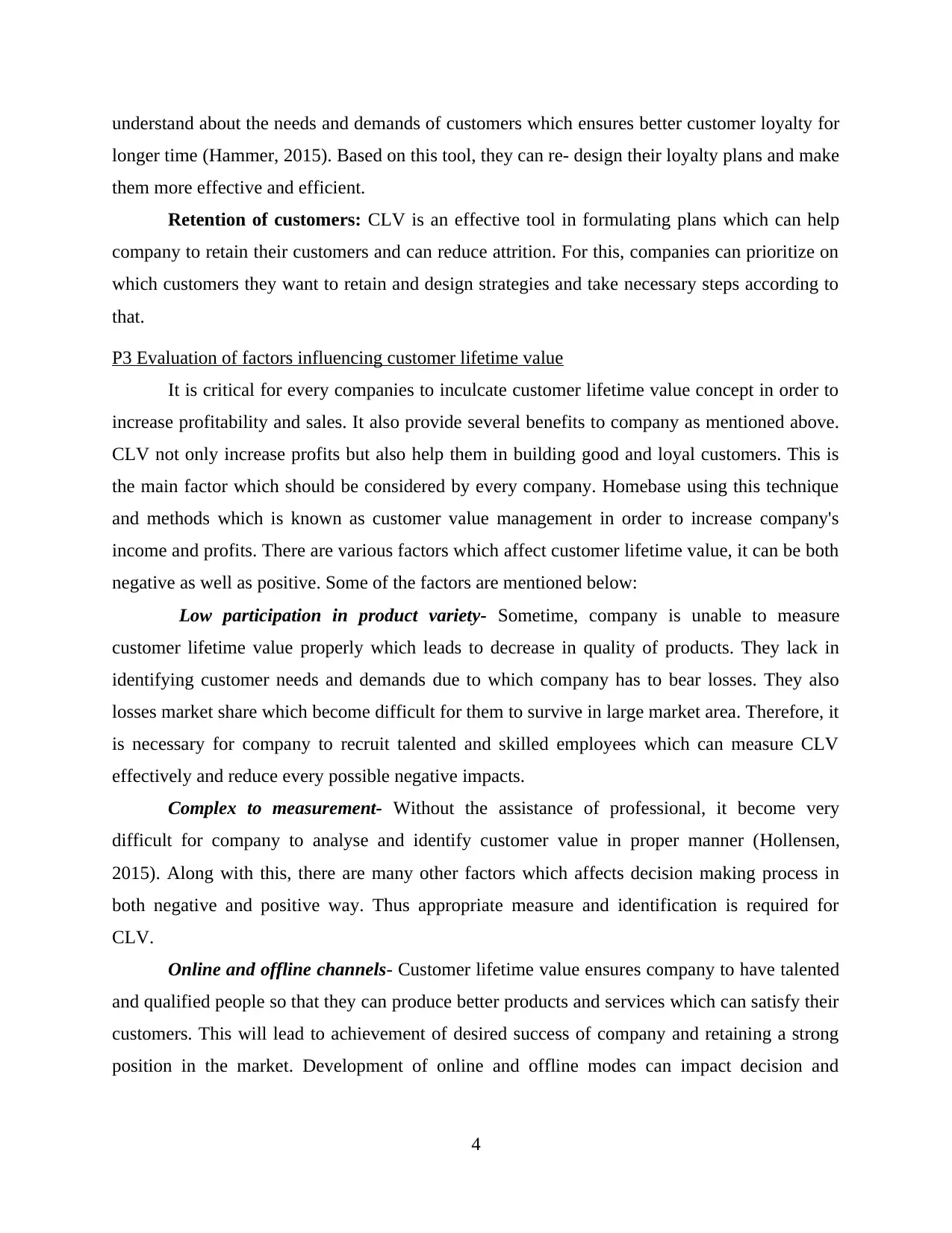
understand about the needs and demands of customers which ensures better customer loyalty for
longer time (Hammer, 2015). Based on this tool, they can re- design their loyalty plans and make
them more effective and efficient.
Retention of customers: CLV is an effective tool in formulating plans which can help
company to retain their customers and can reduce attrition. For this, companies can prioritize on
which customers they want to retain and design strategies and take necessary steps according to
that.
P3 Evaluation of factors influencing customer lifetime value
It is critical for every companies to inculcate customer lifetime value concept in order to
increase profitability and sales. It also provide several benefits to company as mentioned above.
CLV not only increase profits but also help them in building good and loyal customers. This is
the main factor which should be considered by every company. Homebase using this technique
and methods which is known as customer value management in order to increase company's
income and profits. There are various factors which affect customer lifetime value, it can be both
negative as well as positive. Some of the factors are mentioned below:
Low participation in product variety- Sometime, company is unable to measure
customer lifetime value properly which leads to decrease in quality of products. They lack in
identifying customer needs and demands due to which company has to bear losses. They also
losses market share which become difficult for them to survive in large market area. Therefore, it
is necessary for company to recruit talented and skilled employees which can measure CLV
effectively and reduce every possible negative impacts.
Complex to measurement- Without the assistance of professional, it become very
difficult for company to analyse and identify customer value in proper manner (Hollensen,
2015). Along with this, there are many other factors which affects decision making process in
both negative and positive way. Thus appropriate measure and identification is required for
CLV.
Online and offline channels- Customer lifetime value ensures company to have talented
and qualified people so that they can produce better products and services which can satisfy their
customers. This will lead to achievement of desired success of company and retaining a strong
position in the market. Development of online and offline modes can impact decision and
4
longer time (Hammer, 2015). Based on this tool, they can re- design their loyalty plans and make
them more effective and efficient.
Retention of customers: CLV is an effective tool in formulating plans which can help
company to retain their customers and can reduce attrition. For this, companies can prioritize on
which customers they want to retain and design strategies and take necessary steps according to
that.
P3 Evaluation of factors influencing customer lifetime value
It is critical for every companies to inculcate customer lifetime value concept in order to
increase profitability and sales. It also provide several benefits to company as mentioned above.
CLV not only increase profits but also help them in building good and loyal customers. This is
the main factor which should be considered by every company. Homebase using this technique
and methods which is known as customer value management in order to increase company's
income and profits. There are various factors which affect customer lifetime value, it can be both
negative as well as positive. Some of the factors are mentioned below:
Low participation in product variety- Sometime, company is unable to measure
customer lifetime value properly which leads to decrease in quality of products. They lack in
identifying customer needs and demands due to which company has to bear losses. They also
losses market share which become difficult for them to survive in large market area. Therefore, it
is necessary for company to recruit talented and skilled employees which can measure CLV
effectively and reduce every possible negative impacts.
Complex to measurement- Without the assistance of professional, it become very
difficult for company to analyse and identify customer value in proper manner (Hollensen,
2015). Along with this, there are many other factors which affects decision making process in
both negative and positive way. Thus appropriate measure and identification is required for
CLV.
Online and offline channels- Customer lifetime value ensures company to have talented
and qualified people so that they can produce better products and services which can satisfy their
customers. This will lead to achievement of desired success of company and retaining a strong
position in the market. Development of online and offline modes can impact decision and
4
⊘ This is a preview!⊘
Do you want full access?
Subscribe today to unlock all pages.

Trusted by 1+ million students worldwide
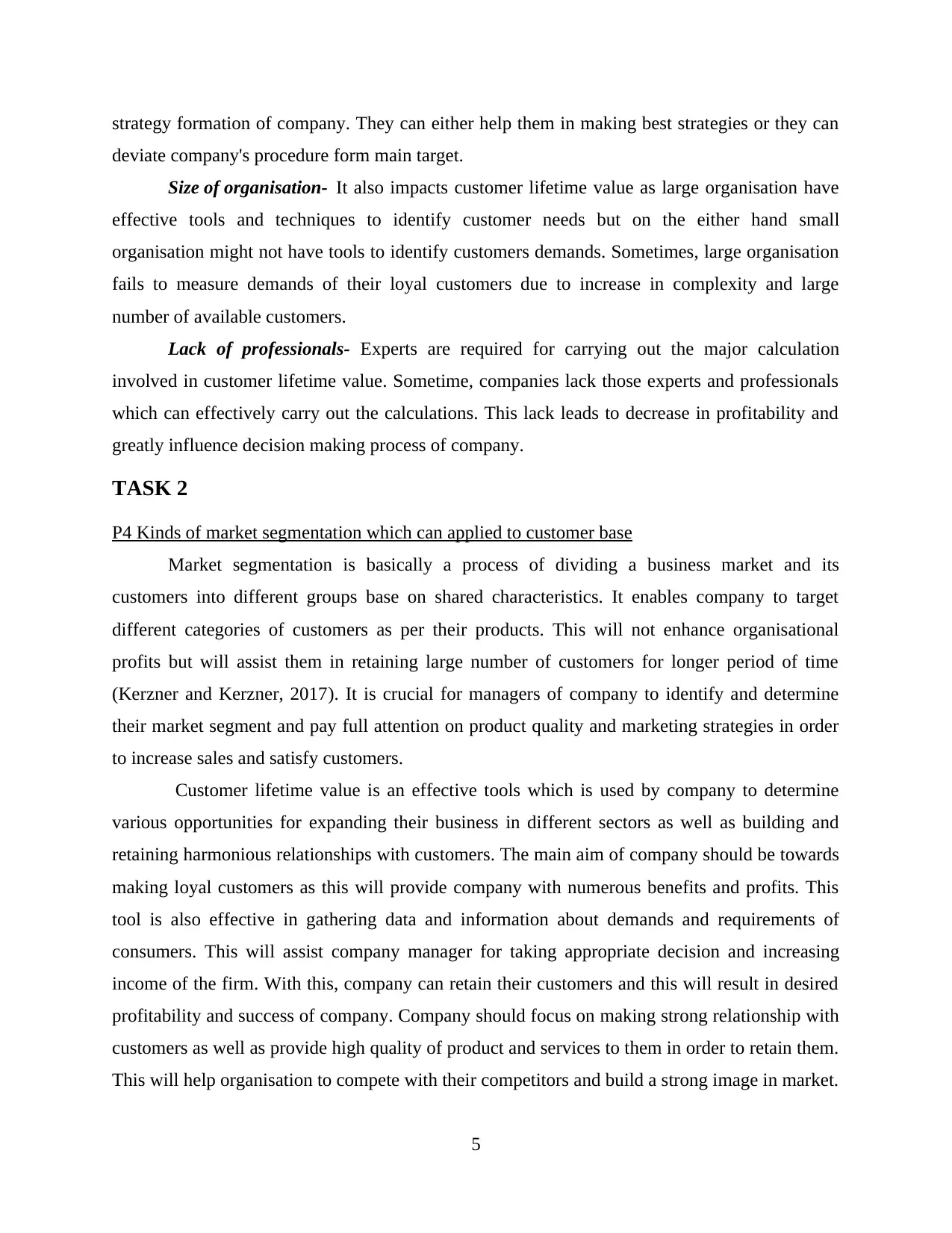
strategy formation of company. They can either help them in making best strategies or they can
deviate company's procedure form main target.
Size of organisation- It also impacts customer lifetime value as large organisation have
effective tools and techniques to identify customer needs but on the either hand small
organisation might not have tools to identify customers demands. Sometimes, large organisation
fails to measure demands of their loyal customers due to increase in complexity and large
number of available customers.
Lack of professionals- Experts are required for carrying out the major calculation
involved in customer lifetime value. Sometime, companies lack those experts and professionals
which can effectively carry out the calculations. This lack leads to decrease in profitability and
greatly influence decision making process of company.
TASK 2
P4 Kinds of market segmentation which can applied to customer base
Market segmentation is basically a process of dividing a business market and its
customers into different groups base on shared characteristics. It enables company to target
different categories of customers as per their products. This will not enhance organisational
profits but will assist them in retaining large number of customers for longer period of time
(Kerzner and Kerzner, 2017). It is crucial for managers of company to identify and determine
their market segment and pay full attention on product quality and marketing strategies in order
to increase sales and satisfy customers.
Customer lifetime value is an effective tools which is used by company to determine
various opportunities for expanding their business in different sectors as well as building and
retaining harmonious relationships with customers. The main aim of company should be towards
making loyal customers as this will provide company with numerous benefits and profits. This
tool is also effective in gathering data and information about demands and requirements of
consumers. This will assist company manager for taking appropriate decision and increasing
income of the firm. With this, company can retain their customers and this will result in desired
profitability and success of company. Company should focus on making strong relationship with
customers as well as provide high quality of product and services to them in order to retain them.
This will help organisation to compete with their competitors and build a strong image in market.
5
deviate company's procedure form main target.
Size of organisation- It also impacts customer lifetime value as large organisation have
effective tools and techniques to identify customer needs but on the either hand small
organisation might not have tools to identify customers demands. Sometimes, large organisation
fails to measure demands of their loyal customers due to increase in complexity and large
number of available customers.
Lack of professionals- Experts are required for carrying out the major calculation
involved in customer lifetime value. Sometime, companies lack those experts and professionals
which can effectively carry out the calculations. This lack leads to decrease in profitability and
greatly influence decision making process of company.
TASK 2
P4 Kinds of market segmentation which can applied to customer base
Market segmentation is basically a process of dividing a business market and its
customers into different groups base on shared characteristics. It enables company to target
different categories of customers as per their products. This will not enhance organisational
profits but will assist them in retaining large number of customers for longer period of time
(Kerzner and Kerzner, 2017). It is crucial for managers of company to identify and determine
their market segment and pay full attention on product quality and marketing strategies in order
to increase sales and satisfy customers.
Customer lifetime value is an effective tools which is used by company to determine
various opportunities for expanding their business in different sectors as well as building and
retaining harmonious relationships with customers. The main aim of company should be towards
making loyal customers as this will provide company with numerous benefits and profits. This
tool is also effective in gathering data and information about demands and requirements of
consumers. This will assist company manager for taking appropriate decision and increasing
income of the firm. With this, company can retain their customers and this will result in desired
profitability and success of company. Company should focus on making strong relationship with
customers as well as provide high quality of product and services to them in order to retain them.
This will help organisation to compete with their competitors and build a strong image in market.
5
Paraphrase This Document
Need a fresh take? Get an instant paraphrase of this document with our AI Paraphraser
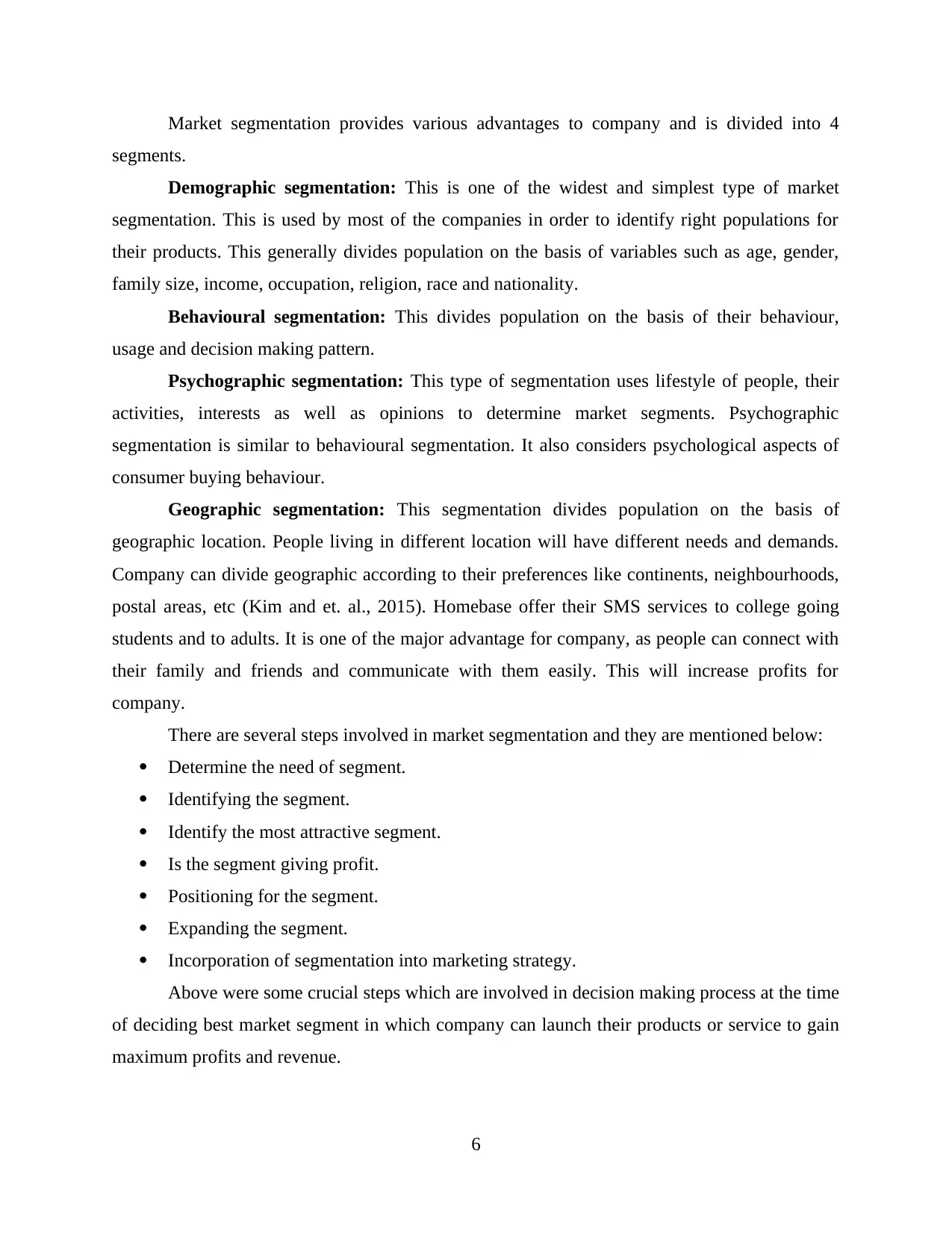
Market segmentation provides various advantages to company and is divided into 4
segments.
Demographic segmentation: This is one of the widest and simplest type of market
segmentation. This is used by most of the companies in order to identify right populations for
their products. This generally divides population on the basis of variables such as age, gender,
family size, income, occupation, religion, race and nationality.
Behavioural segmentation: This divides population on the basis of their behaviour,
usage and decision making pattern.
Psychographic segmentation: This type of segmentation uses lifestyle of people, their
activities, interests as well as opinions to determine market segments. Psychographic
segmentation is similar to behavioural segmentation. It also considers psychological aspects of
consumer buying behaviour.
Geographic segmentation: This segmentation divides population on the basis of
geographic location. People living in different location will have different needs and demands.
Company can divide geographic according to their preferences like continents, neighbourhoods,
postal areas, etc (Kim and et. al., 2015). Homebase offer their SMS services to college going
students and to adults. It is one of the major advantage for company, as people can connect with
their family and friends and communicate with them easily. This will increase profits for
company.
There are several steps involved in market segmentation and they are mentioned below:
Determine the need of segment.
Identifying the segment.
Identify the most attractive segment.
Is the segment giving profit.
Positioning for the segment.
Expanding the segment.
Incorporation of segmentation into marketing strategy.
Above were some crucial steps which are involved in decision making process at the time
of deciding best market segment in which company can launch their products or service to gain
maximum profits and revenue.
6
segments.
Demographic segmentation: This is one of the widest and simplest type of market
segmentation. This is used by most of the companies in order to identify right populations for
their products. This generally divides population on the basis of variables such as age, gender,
family size, income, occupation, religion, race and nationality.
Behavioural segmentation: This divides population on the basis of their behaviour,
usage and decision making pattern.
Psychographic segmentation: This type of segmentation uses lifestyle of people, their
activities, interests as well as opinions to determine market segments. Psychographic
segmentation is similar to behavioural segmentation. It also considers psychological aspects of
consumer buying behaviour.
Geographic segmentation: This segmentation divides population on the basis of
geographic location. People living in different location will have different needs and demands.
Company can divide geographic according to their preferences like continents, neighbourhoods,
postal areas, etc (Kim and et. al., 2015). Homebase offer their SMS services to college going
students and to adults. It is one of the major advantage for company, as people can connect with
their family and friends and communicate with them easily. This will increase profits for
company.
There are several steps involved in market segmentation and they are mentioned below:
Determine the need of segment.
Identifying the segment.
Identify the most attractive segment.
Is the segment giving profit.
Positioning for the segment.
Expanding the segment.
Incorporation of segmentation into marketing strategy.
Above were some crucial steps which are involved in decision making process at the time
of deciding best market segment in which company can launch their products or service to gain
maximum profits and revenue.
6
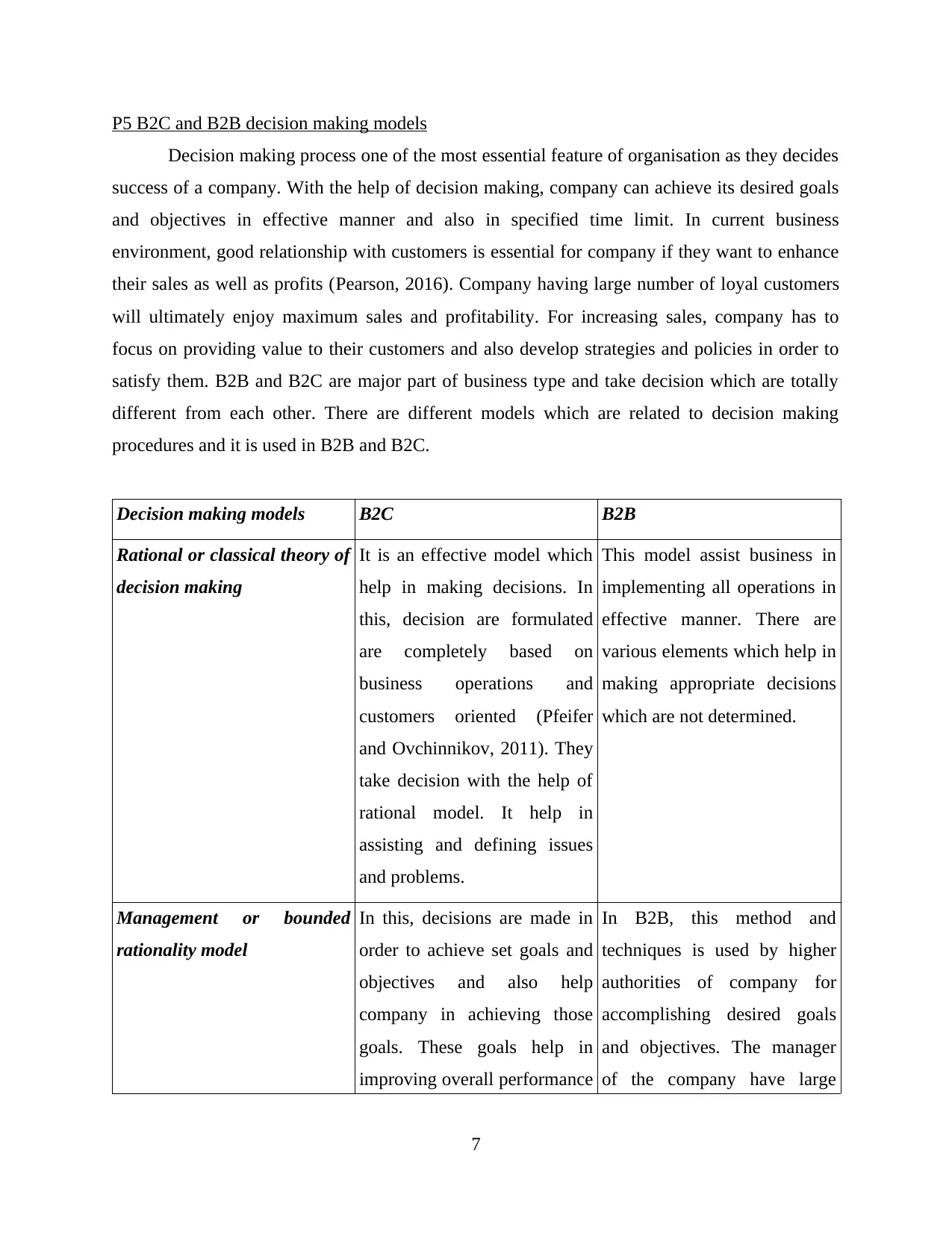
P5 B2C and B2B decision making models
Decision making process one of the most essential feature of organisation as they decides
success of a company. With the help of decision making, company can achieve its desired goals
and objectives in effective manner and also in specified time limit. In current business
environment, good relationship with customers is essential for company if they want to enhance
their sales as well as profits (Pearson, 2016). Company having large number of loyal customers
will ultimately enjoy maximum sales and profitability. For increasing sales, company has to
focus on providing value to their customers and also develop strategies and policies in order to
satisfy them. B2B and B2C are major part of business type and take decision which are totally
different from each other. There are different models which are related to decision making
procedures and it is used in B2B and B2C.
Decision making models B2C B2B
Rational or classical theory of
decision making
It is an effective model which
help in making decisions. In
this, decision are formulated
are completely based on
business operations and
customers oriented (Pfeifer
and Ovchinnikov, 2011). They
take decision with the help of
rational model. It help in
assisting and defining issues
and problems.
This model assist business in
implementing all operations in
effective manner. There are
various elements which help in
making appropriate decisions
which are not determined.
Management or bounded
rationality model
In this, decisions are made in
order to achieve set goals and
objectives and also help
company in achieving those
goals. These goals help in
improving overall performance
In B2B, this method and
techniques is used by higher
authorities of company for
accomplishing desired goals
and objectives. The manager
of the company have large
7
Decision making process one of the most essential feature of organisation as they decides
success of a company. With the help of decision making, company can achieve its desired goals
and objectives in effective manner and also in specified time limit. In current business
environment, good relationship with customers is essential for company if they want to enhance
their sales as well as profits (Pearson, 2016). Company having large number of loyal customers
will ultimately enjoy maximum sales and profitability. For increasing sales, company has to
focus on providing value to their customers and also develop strategies and policies in order to
satisfy them. B2B and B2C are major part of business type and take decision which are totally
different from each other. There are different models which are related to decision making
procedures and it is used in B2B and B2C.
Decision making models B2C B2B
Rational or classical theory of
decision making
It is an effective model which
help in making decisions. In
this, decision are formulated
are completely based on
business operations and
customers oriented (Pfeifer
and Ovchinnikov, 2011). They
take decision with the help of
rational model. It help in
assisting and defining issues
and problems.
This model assist business in
implementing all operations in
effective manner. There are
various elements which help in
making appropriate decisions
which are not determined.
Management or bounded
rationality model
In this, decisions are made in
order to achieve set goals and
objectives and also help
company in achieving those
goals. These goals help in
improving overall performance
In B2B, this method and
techniques is used by higher
authorities of company for
accomplishing desired goals
and objectives. The manager
of the company have large
7
⊘ This is a preview!⊘
Do you want full access?
Subscribe today to unlock all pages.

Trusted by 1+ million students worldwide
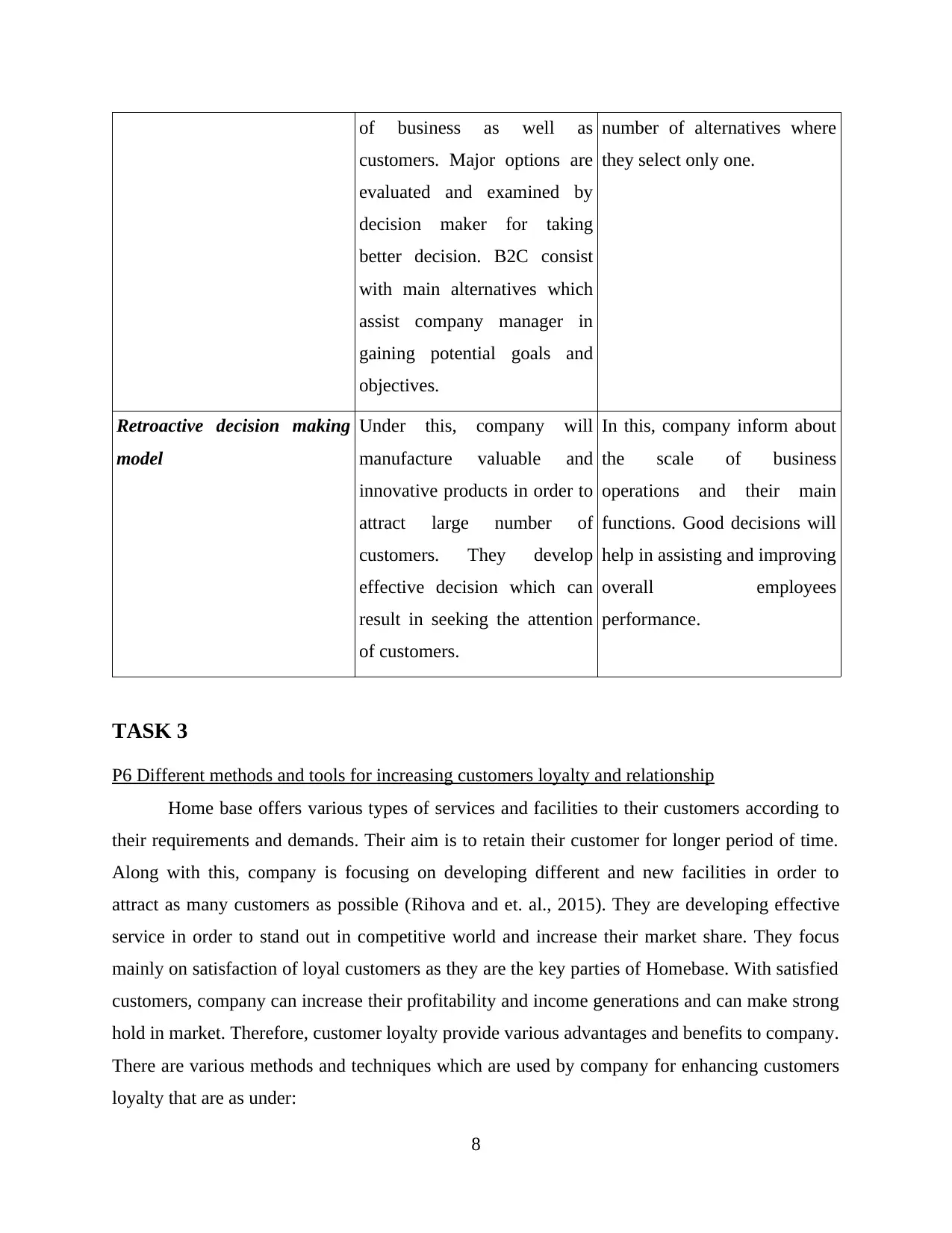
of business as well as
customers. Major options are
evaluated and examined by
decision maker for taking
better decision. B2C consist
with main alternatives which
assist company manager in
gaining potential goals and
objectives.
number of alternatives where
they select only one.
Retroactive decision making
model
Under this, company will
manufacture valuable and
innovative products in order to
attract large number of
customers. They develop
effective decision which can
result in seeking the attention
of customers.
In this, company inform about
the scale of business
operations and their main
functions. Good decisions will
help in assisting and improving
overall employees
performance.
TASK 3
P6 Different methods and tools for increasing customers loyalty and relationship
Home base offers various types of services and facilities to their customers according to
their requirements and demands. Their aim is to retain their customer for longer period of time.
Along with this, company is focusing on developing different and new facilities in order to
attract as many customers as possible (Rihova and et. al., 2015). They are developing effective
service in order to stand out in competitive world and increase their market share. They focus
mainly on satisfaction of loyal customers as they are the key parties of Homebase. With satisfied
customers, company can increase their profitability and income generations and can make strong
hold in market. Therefore, customer loyalty provide various advantages and benefits to company.
There are various methods and techniques which are used by company for enhancing customers
loyalty that are as under:
8
customers. Major options are
evaluated and examined by
decision maker for taking
better decision. B2C consist
with main alternatives which
assist company manager in
gaining potential goals and
objectives.
number of alternatives where
they select only one.
Retroactive decision making
model
Under this, company will
manufacture valuable and
innovative products in order to
attract large number of
customers. They develop
effective decision which can
result in seeking the attention
of customers.
In this, company inform about
the scale of business
operations and their main
functions. Good decisions will
help in assisting and improving
overall employees
performance.
TASK 3
P6 Different methods and tools for increasing customers loyalty and relationship
Home base offers various types of services and facilities to their customers according to
their requirements and demands. Their aim is to retain their customer for longer period of time.
Along with this, company is focusing on developing different and new facilities in order to
attract as many customers as possible (Rihova and et. al., 2015). They are developing effective
service in order to stand out in competitive world and increase their market share. They focus
mainly on satisfaction of loyal customers as they are the key parties of Homebase. With satisfied
customers, company can increase their profitability and income generations and can make strong
hold in market. Therefore, customer loyalty provide various advantages and benefits to company.
There are various methods and techniques which are used by company for enhancing customers
loyalty that are as under:
8
Paraphrase This Document
Need a fresh take? Get an instant paraphrase of this document with our AI Paraphraser
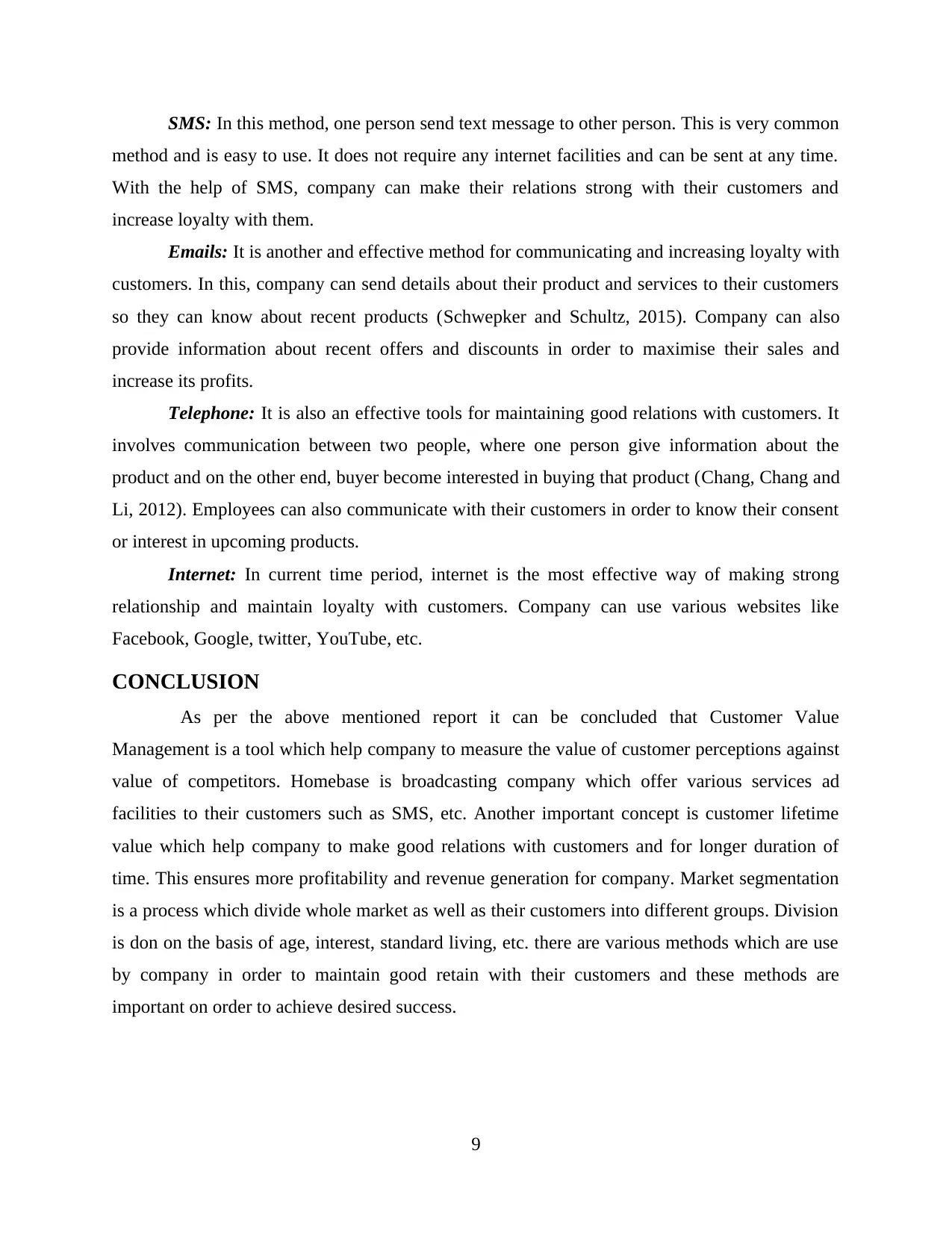
SMS: In this method, one person send text message to other person. This is very common
method and is easy to use. It does not require any internet facilities and can be sent at any time.
With the help of SMS, company can make their relations strong with their customers and
increase loyalty with them.
Emails: It is another and effective method for communicating and increasing loyalty with
customers. In this, company can send details about their product and services to their customers
so they can know about recent products (Schwepker and Schultz, 2015). Company can also
provide information about recent offers and discounts in order to maximise their sales and
increase its profits.
Telephone: It is also an effective tools for maintaining good relations with customers. It
involves communication between two people, where one person give information about the
product and on the other end, buyer become interested in buying that product (Chang, Chang and
Li, 2012). Employees can also communicate with their customers in order to know their consent
or interest in upcoming products.
Internet: In current time period, internet is the most effective way of making strong
relationship and maintain loyalty with customers. Company can use various websites like
Facebook, Google, twitter, YouTube, etc.
CONCLUSION
As per the above mentioned report it can be concluded that Customer Value
Management is a tool which help company to measure the value of customer perceptions against
value of competitors. Homebase is broadcasting company which offer various services ad
facilities to their customers such as SMS, etc. Another important concept is customer lifetime
value which help company to make good relations with customers and for longer duration of
time. This ensures more profitability and revenue generation for company. Market segmentation
is a process which divide whole market as well as their customers into different groups. Division
is don on the basis of age, interest, standard living, etc. there are various methods which are use
by company in order to maintain good retain with their customers and these methods are
important on order to achieve desired success.
9
method and is easy to use. It does not require any internet facilities and can be sent at any time.
With the help of SMS, company can make their relations strong with their customers and
increase loyalty with them.
Emails: It is another and effective method for communicating and increasing loyalty with
customers. In this, company can send details about their product and services to their customers
so they can know about recent products (Schwepker and Schultz, 2015). Company can also
provide information about recent offers and discounts in order to maximise their sales and
increase its profits.
Telephone: It is also an effective tools for maintaining good relations with customers. It
involves communication between two people, where one person give information about the
product and on the other end, buyer become interested in buying that product (Chang, Chang and
Li, 2012). Employees can also communicate with their customers in order to know their consent
or interest in upcoming products.
Internet: In current time period, internet is the most effective way of making strong
relationship and maintain loyalty with customers. Company can use various websites like
Facebook, Google, twitter, YouTube, etc.
CONCLUSION
As per the above mentioned report it can be concluded that Customer Value
Management is a tool which help company to measure the value of customer perceptions against
value of competitors. Homebase is broadcasting company which offer various services ad
facilities to their customers such as SMS, etc. Another important concept is customer lifetime
value which help company to make good relations with customers and for longer duration of
time. This ensures more profitability and revenue generation for company. Market segmentation
is a process which divide whole market as well as their customers into different groups. Division
is don on the basis of age, interest, standard living, etc. there are various methods which are use
by company in order to maintain good retain with their customers and these methods are
important on order to achieve desired success.
9
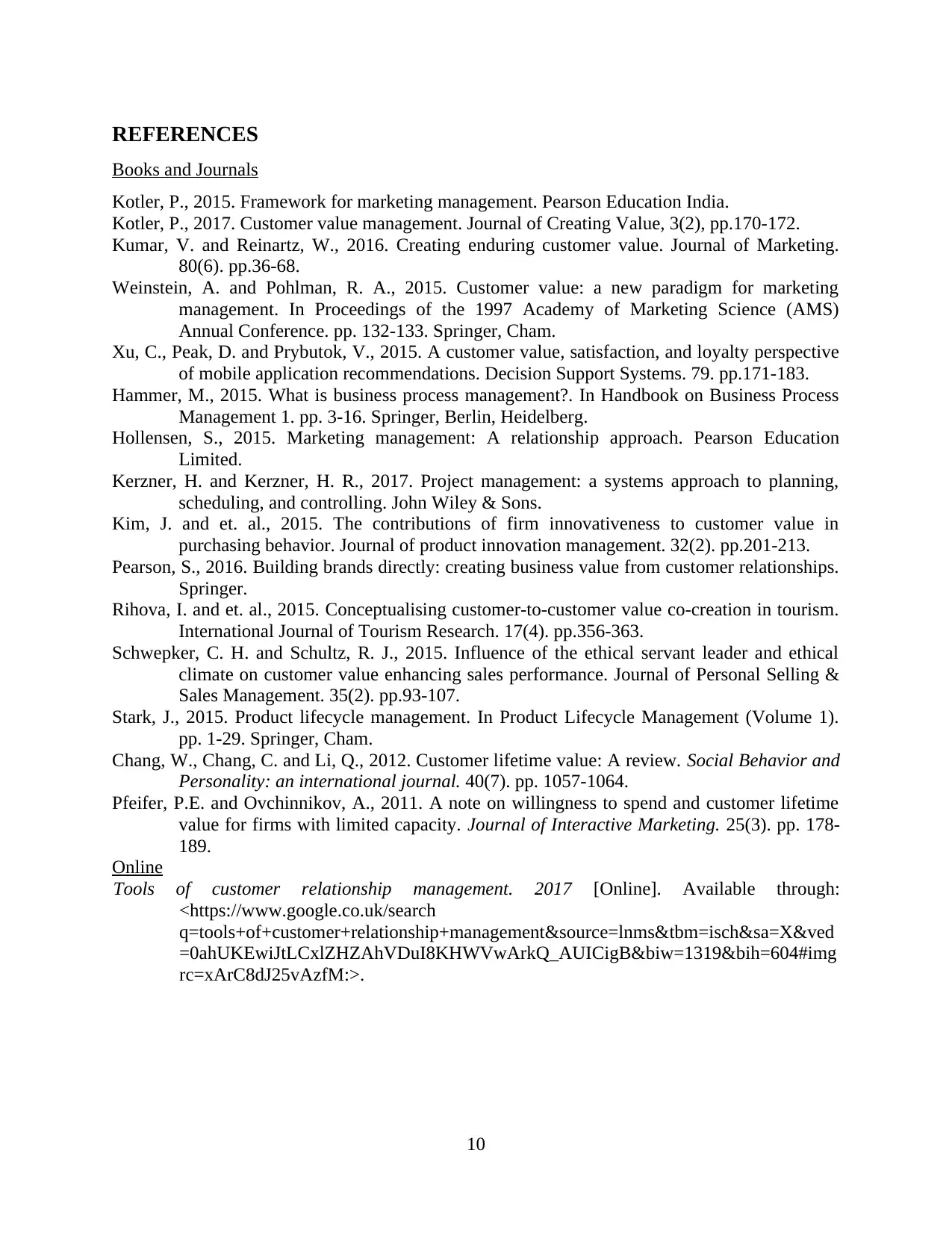
REFERENCES
Books and Journals
Kotler, P., 2015. Framework for marketing management. Pearson Education India.
Kotler, P., 2017. Customer value management. Journal of Creating Value, 3(2), pp.170-172.
Kumar, V. and Reinartz, W., 2016. Creating enduring customer value. Journal of Marketing.
80(6). pp.36-68.
Weinstein, A. and Pohlman, R. A., 2015. Customer value: a new paradigm for marketing
management. In Proceedings of the 1997 Academy of Marketing Science (AMS)
Annual Conference. pp. 132-133. Springer, Cham.
Xu, C., Peak, D. and Prybutok, V., 2015. A customer value, satisfaction, and loyalty perspective
of mobile application recommendations. Decision Support Systems. 79. pp.171-183.
Hammer, M., 2015. What is business process management?. In Handbook on Business Process
Management 1. pp. 3-16. Springer, Berlin, Heidelberg.
Hollensen, S., 2015. Marketing management: A relationship approach. Pearson Education
Limited.
Kerzner, H. and Kerzner, H. R., 2017. Project management: a systems approach to planning,
scheduling, and controlling. John Wiley & Sons.
Kim, J. and et. al., 2015. The contributions of firm innovativeness to customer value in
purchasing behavior. Journal of product innovation management. 32(2). pp.201-213.
Pearson, S., 2016. Building brands directly: creating business value from customer relationships.
Springer.
Rihova, I. and et. al., 2015. Conceptualising customer‐to‐customer value co‐creation in tourism.
International Journal of Tourism Research. 17(4). pp.356-363.
Schwepker, C. H. and Schultz, R. J., 2015. Influence of the ethical servant leader and ethical
climate on customer value enhancing sales performance. Journal of Personal Selling &
Sales Management. 35(2). pp.93-107.
Stark, J., 2015. Product lifecycle management. In Product Lifecycle Management (Volume 1).
pp. 1-29. Springer, Cham.
Chang, W., Chang, C. and Li, Q., 2012. Customer lifetime value: A review. Social Behavior and
Personality: an international journal. 40(7). pp. 1057-1064.
Pfeifer, P.E. and Ovchinnikov, A., 2011. A note on willingness to spend and customer lifetime
value for firms with limited capacity. Journal of Interactive Marketing. 25(3). pp. 178-
189.
Online
Tools of customer relationship management. 2017 [Online]. Available through:
<https://www.google.co.uk/search
q=tools+of+customer+relationship+management&source=lnms&tbm=isch&sa=X&ved
=0ahUKEwiJtLCxlZHZAhVDuI8KHWVwArkQ_AUICigB&biw=1319&bih=604#img
rc=xArC8dJ25vAzfM:>.
10
Books and Journals
Kotler, P., 2015. Framework for marketing management. Pearson Education India.
Kotler, P., 2017. Customer value management. Journal of Creating Value, 3(2), pp.170-172.
Kumar, V. and Reinartz, W., 2016. Creating enduring customer value. Journal of Marketing.
80(6). pp.36-68.
Weinstein, A. and Pohlman, R. A., 2015. Customer value: a new paradigm for marketing
management. In Proceedings of the 1997 Academy of Marketing Science (AMS)
Annual Conference. pp. 132-133. Springer, Cham.
Xu, C., Peak, D. and Prybutok, V., 2015. A customer value, satisfaction, and loyalty perspective
of mobile application recommendations. Decision Support Systems. 79. pp.171-183.
Hammer, M., 2015. What is business process management?. In Handbook on Business Process
Management 1. pp. 3-16. Springer, Berlin, Heidelberg.
Hollensen, S., 2015. Marketing management: A relationship approach. Pearson Education
Limited.
Kerzner, H. and Kerzner, H. R., 2017. Project management: a systems approach to planning,
scheduling, and controlling. John Wiley & Sons.
Kim, J. and et. al., 2015. The contributions of firm innovativeness to customer value in
purchasing behavior. Journal of product innovation management. 32(2). pp.201-213.
Pearson, S., 2016. Building brands directly: creating business value from customer relationships.
Springer.
Rihova, I. and et. al., 2015. Conceptualising customer‐to‐customer value co‐creation in tourism.
International Journal of Tourism Research. 17(4). pp.356-363.
Schwepker, C. H. and Schultz, R. J., 2015. Influence of the ethical servant leader and ethical
climate on customer value enhancing sales performance. Journal of Personal Selling &
Sales Management. 35(2). pp.93-107.
Stark, J., 2015. Product lifecycle management. In Product Lifecycle Management (Volume 1).
pp. 1-29. Springer, Cham.
Chang, W., Chang, C. and Li, Q., 2012. Customer lifetime value: A review. Social Behavior and
Personality: an international journal. 40(7). pp. 1057-1064.
Pfeifer, P.E. and Ovchinnikov, A., 2011. A note on willingness to spend and customer lifetime
value for firms with limited capacity. Journal of Interactive Marketing. 25(3). pp. 178-
189.
Online
Tools of customer relationship management. 2017 [Online]. Available through:
<https://www.google.co.uk/search
q=tools+of+customer+relationship+management&source=lnms&tbm=isch&sa=X&ved
=0ahUKEwiJtLCxlZHZAhVDuI8KHWVwArkQ_AUICigB&biw=1319&bih=604#img
rc=xArC8dJ25vAzfM:>.
10
⊘ This is a preview!⊘
Do you want full access?
Subscribe today to unlock all pages.

Trusted by 1+ million students worldwide
1 out of 12
Related Documents
Your All-in-One AI-Powered Toolkit for Academic Success.
+13062052269
info@desklib.com
Available 24*7 on WhatsApp / Email
![[object Object]](/_next/static/media/star-bottom.7253800d.svg)
Unlock your academic potential
Copyright © 2020–2025 A2Z Services. All Rights Reserved. Developed and managed by ZUCOL.





